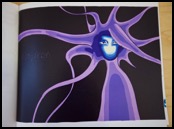Arie Kim
Play with Us
Adventures Within
I was maybe nine. I twisted my neck and pushed my head between the cold bars, then same with the right shoulder and the waist. I slipped right through the tall, steel school fence. Thick wisteria hung to hide me but my heart beat like a fish out of water. Just like that, I was outside the school. I didn’t even have to go anywhere. I just stood there leaning on the fence, and gazed on our house, an ocher-colored apartment building, and the blue sky.
When I come home after school, the house would be empty until it turned indigo outside when mom came back, then dad. I had friends, but I loved staying home alone and watching anime. I loved the characters, movements, and colors, but above all, I loved the adventures. Watching anime, I would travel around with the characters ancient China for cooking battles, turn into Giant Panda, time travel or live in a spaceship. Soon I joined the school’s extracurricular drawing lessons where I learned traditional pencil and charcoal drawing. Then I would spend the evenings after the lessons with a friend sketching our own manga characters and watching anime. Always taking studio art lessons and drawing manga characters on my own time, I dreamt of making a manga of my own or animating characters. It never has been realized because I always gave up before finishing the first character, but having the class structure and support, TSR was a great opportunity to try it out.
Like many of ours, my project idea took a while to settle down. I wanted to make something beautiful and meaningful, but I didn’t want it to be too ambitious. I knew I could achieve a good balance if I made drawings or paintings, something I have done many times before. But Sue’s and Andrew’s voices kept replaying from the first time we all got together, the info session. We were free to do whatever we wanted to, they said, and we would really have a special experience by trying something unfamiliar, something we’ve never done before. So I ditched the idea of making paintings of the sky. No black-and-white still life. I wanted to make the most out of this one-year chance and do something I could only do in this inviting setting.
The enlightenment came when I was reading my biochemistry textbook at the Meyer Library. I read about how bacteria have restriction enzymes that digest viral DNA, and methylases protect the bacteria’s own DNA by marking the digest sites. On the margin next to the paragraph, I drew a quick doodle of restriction enzyme and methylase as a duo of superheros. The doodle seemed spontaneous, carefree, and cute. Most importantly, I wanted to do more like it. I decided to personify proteins and cells that are jargons in Biology and turn them cute and approachable. I wanted to surprise my audience.
Hardship number one was the doubt that my work will be meaningless, unimportant. This doubt was there from the beginning as we shared each other’s ideas. Compared to my peer’s ideas of interviewing patients or saving wildlife, my project seemed trivial. But every workshop, I saw the class was excited about my project. I wanted to show them more. I kept telling myself that there’s nothing wrong with doing it just for the fun of it. The doubt kept shrinking over the months and I enjoyed the process more and more.
Hardship number two was keeping myself motivated. One memorable scene from The Creative Habit was where Tharp gets on a taxi in the blue NYC dawn to get her morning exercise done at the gym. It was unexpected for me that being self-disciplined would be an important part of creativity for someone. Now I know that unless you’re finishing your entire artwork in one sitting, self-discipline is really important in art. For many weeks, the night before workshop day was dreadful because I wasn’t prepared. And the pressure of having to show something new was tremendous. The more I knew I had to start early, the more I delayed working on it, and the pressure just built up. If we didn’t have regular workshops, however, I couldn’t have ever finished the project. As the final exhibition date approached, everything wound down and wrapped themselves up.
I was once asked to describe why I joined the cross country team in high school. It was at a team dinner at the start of a new season. All two dozens of us filled coach Browse's living room like a flock of penguins. Having to come up with my answer on the spot and speak in front of everyone, my heartbeat had ramped up like I was running a marathon. I thought about how every moment of a race you're getting closer to finishing and how there's no foul in cross country. I answered that cross country is an honest sport where every step counts toward the goal.
As I came to Stanford and became responsible for pacing myself, I had to run over many hurdles, sometimes around them. And my track has been a winding one. Now I wonder if I have been running toward my goal, or if I have explored too much. Perhaps real life is so complicated that nothing really counts toward a goal. Perhaps you adjust your goal every step of the way, to make yourself feel better. Or perhaps, everything you have done really does count. For me, No matter which it is, I feel clearly that I have become a different person and made at least some progress in accepting myself. I can finally say I am happy, hopeful, and grateful, and I believe I will have some wonderful adventures ahead of me.




